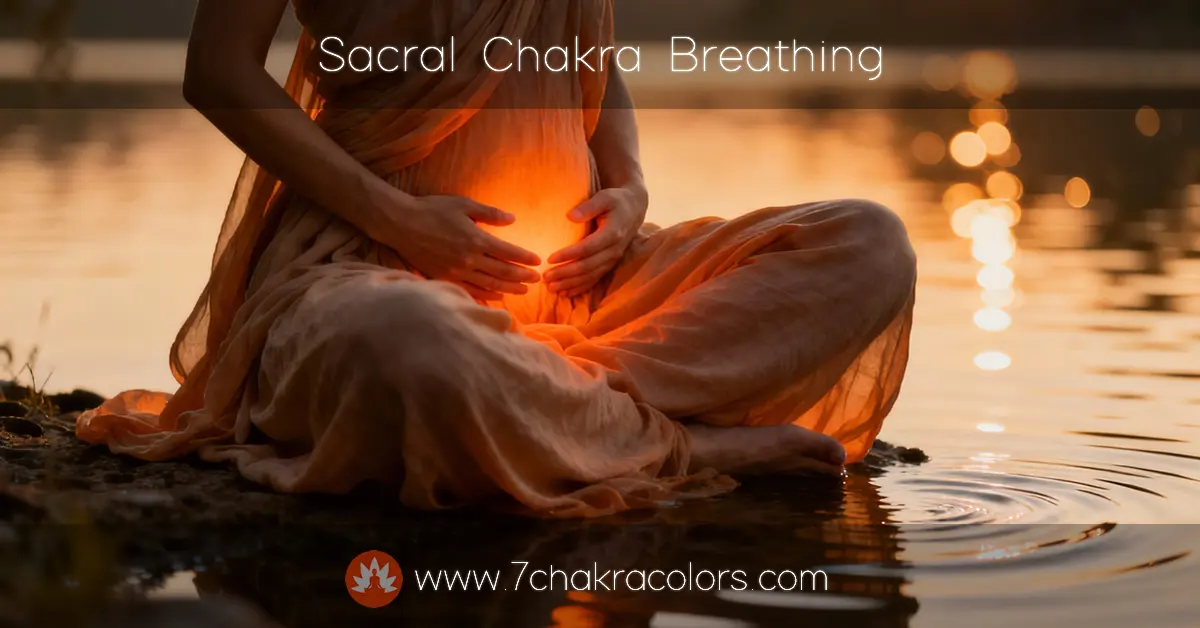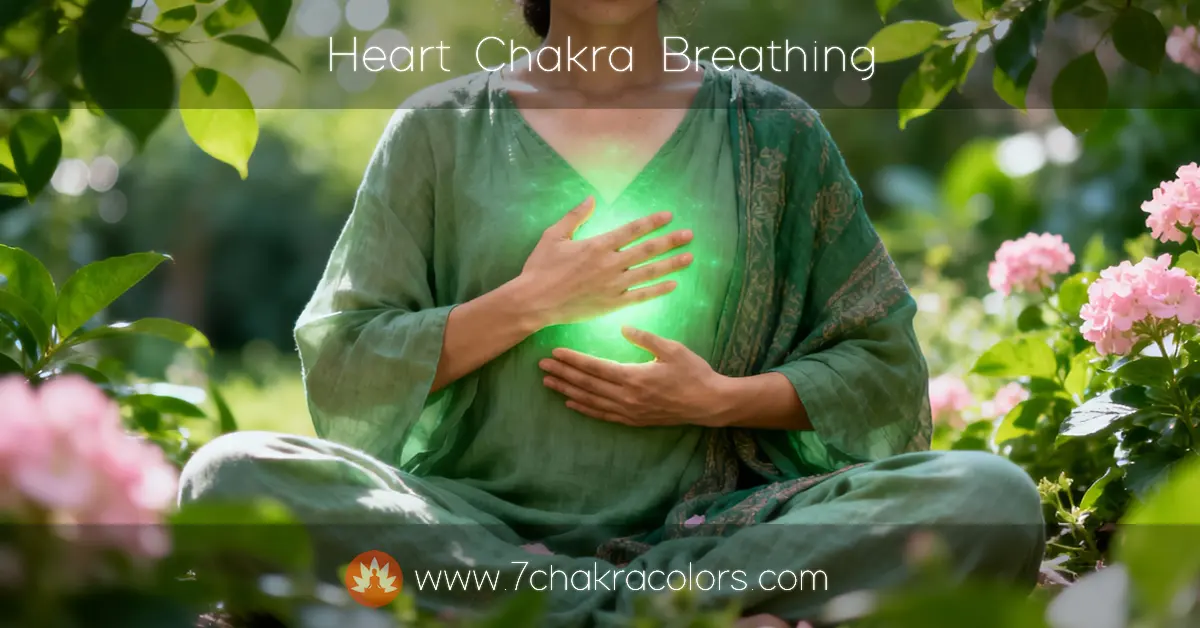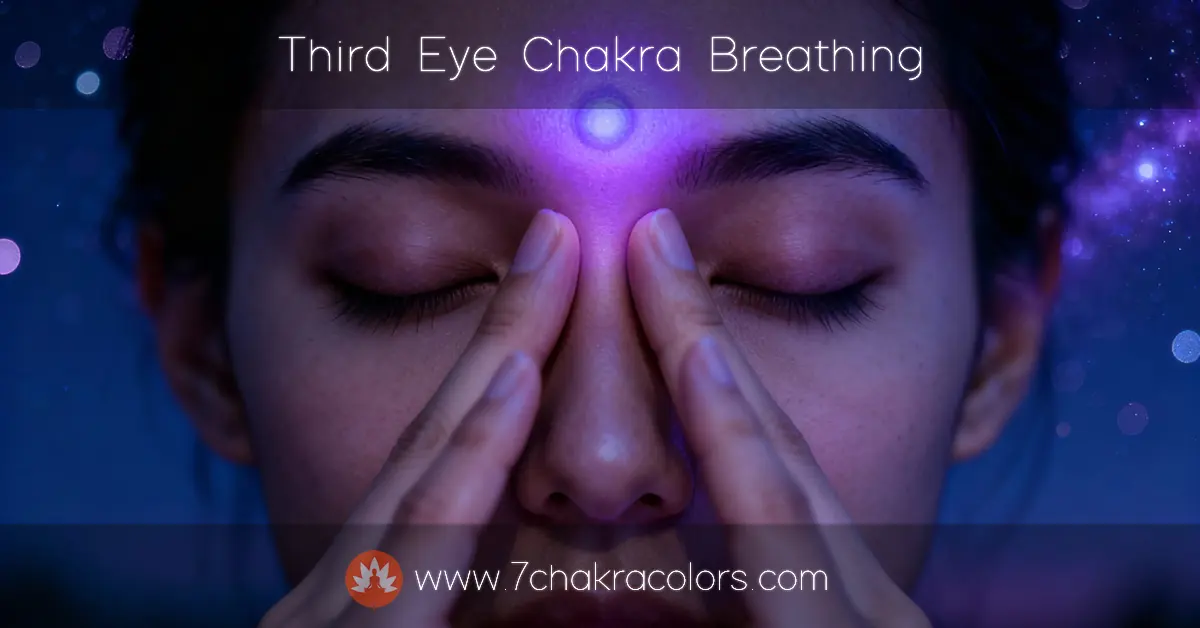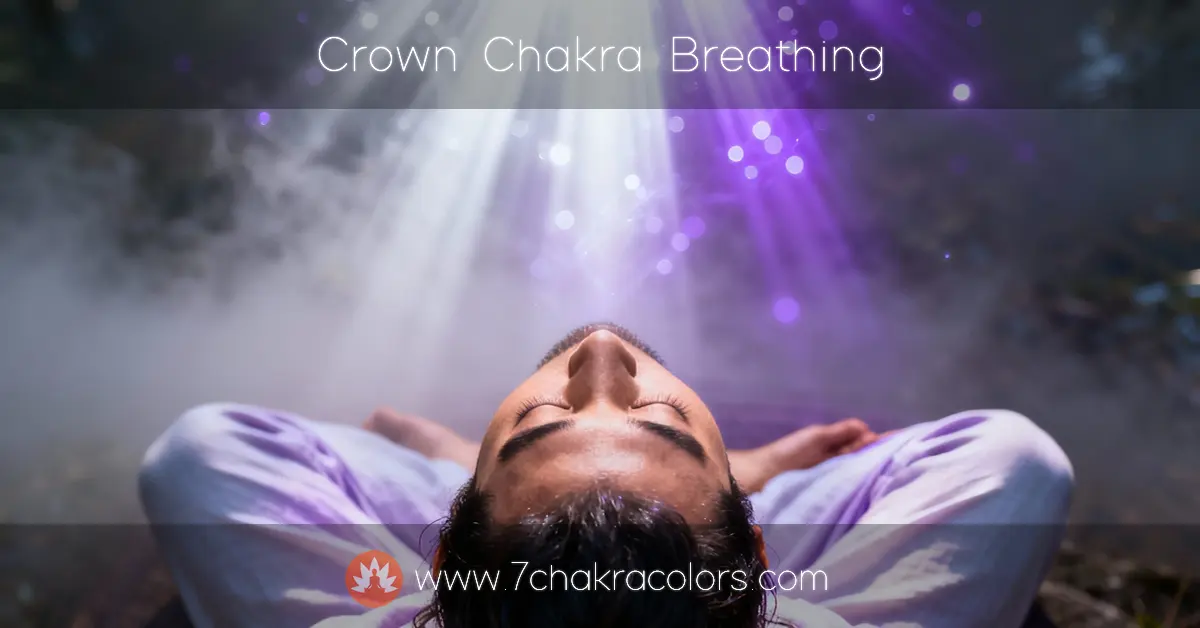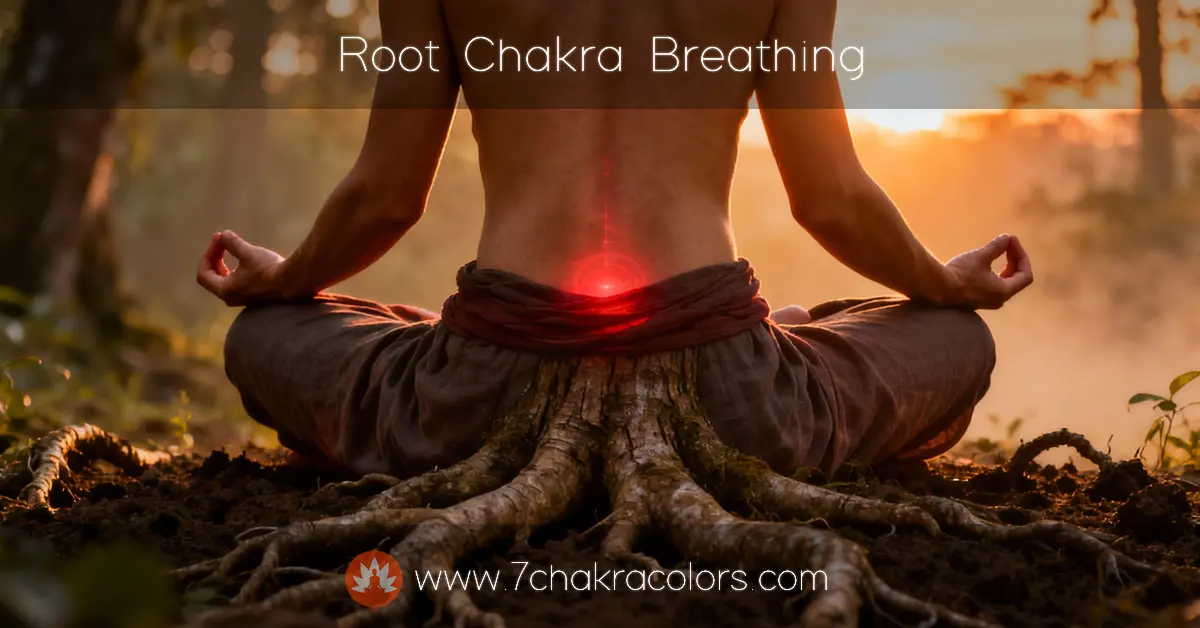
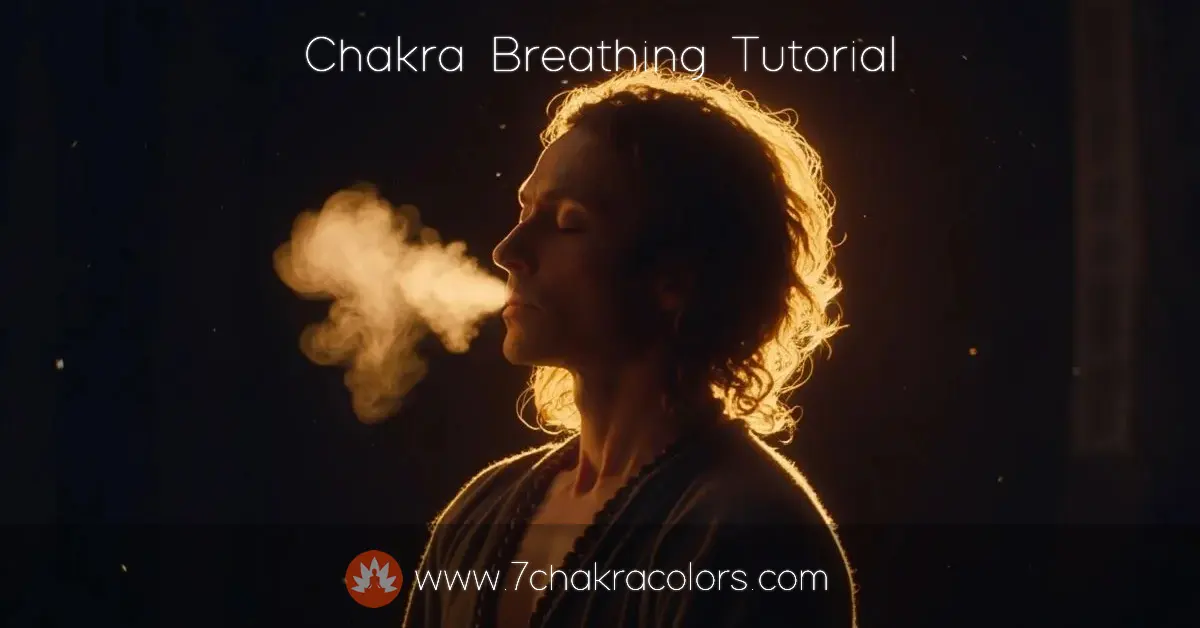
Learn 55+ chakra breathing exercises to balance your energy centers. Complete guide with step-by-step techniques for all seven chakras.
Your breath connects directly to your energy system. Not metaphorically - actually. Every inhale and exhale moves more than just oxygen through your body. It shifts energy, clears blockages, and activates the seven major energy centers running up your spine.
These energy centers? We call them chakras.
Most people breathe shallow, stuck in their chest. That pattern keeps energy trapped in your upper body while your foundation starves. Chakra breathing changes that. It teaches you to direct breath - and energy - exactly where you need it.
This isn't complicated mysticism. It's practical technique that people have used for thousands of years to feel more balanced, grounded, and alive. You're about to learn how to work with your energy system using the most basic tool you have.
Your breath.
Seven main chakras run from your tailbone to the crown of your head. Each one handles different aspects of your physical, emotional, and spiritual life. When energy flows freely through all seven, you feel balanced. When something gets stuck or overactive, you notice it - tension, anxiety, disconnection, physical symptoms. Learn more about each energy center in our complete chakra guide.
The root chakra at your tailbone deals with safety and survival. Your sacral chakra below your navel handles creativity and emotions. Solar plexus sits at your stomach and manages personal power. Heart chakra governs love and connection. Throat chakra controls communication. Third eye between your eyebrows handles intuition. Crown chakra at the top of your head connects you to something larger than yourself.
Energy moves through these centers constantly. Or it should. What happens is that stress, trauma, poor posture, and disconnection create blockages. Energy gets stuck somewhere around your ribs or can't reach your foundation.
Breathing exercises for chakras clear those blockages.
Breath carries prana - that's life force energy. Ancient yogis understood this connection thousands of years ago. Modern science is starting to catch up, mapping how different breathing patterns affect your nervous system, brain waves, and cellular function.
When you breathe shallow and fast, energy stays trapped in your upper chakras. You're stuck in your head, anxious, disconnected from your body. When you breathe deep and slow, directing attention to your lower chakras, energy drops. You feel grounded. Present.
Here's what matters - where you place your attention during breath actually directs energy to that area. Your awareness combined with intentional breathing creates real physiological changes. Blood flow increases. Neural pathways activate. The energy center you're focusing on literally wakes up.
This isn't belief-based practice. You don't have to think chakras are real. Just breathe with intention and notice what happens in your body.
Three major energy channels run through your body. Understanding them helps you work with chakra breath more effectively. These nadis - that's what they're called in Sanskrit - carry prana to all your chakras.
Sushumna runs straight up your spine from root to crown. It's your central highway for energy. All seven major chakras sit along this channel. When sushumna is clear and active, energy flows freely between chakras. You feel balanced, aligned, connected.
Most people's sushumna stays partially dormant. Energy trickles through rather than flowing. Chakra breathing techniques activate this central channel, opening the pathway for energy to move the way it's supposed to.
Ida runs along the left side of your spine. It carries cooling, calming, feminine energy. This channel connects to your parasympathetic nervous system - the rest and digest mode. When ida is active, you feel peaceful, receptive, intuitive.
You activate ida by breathing through your left nostril.
Pingala mirrors ida on the right side. It carries heating, energizing, masculine energy. This channel links to your sympathetic nervous system - your action mode. When pingala is active, you feel energized, focused, ready to move.
Right nostril breathing activates pingala.
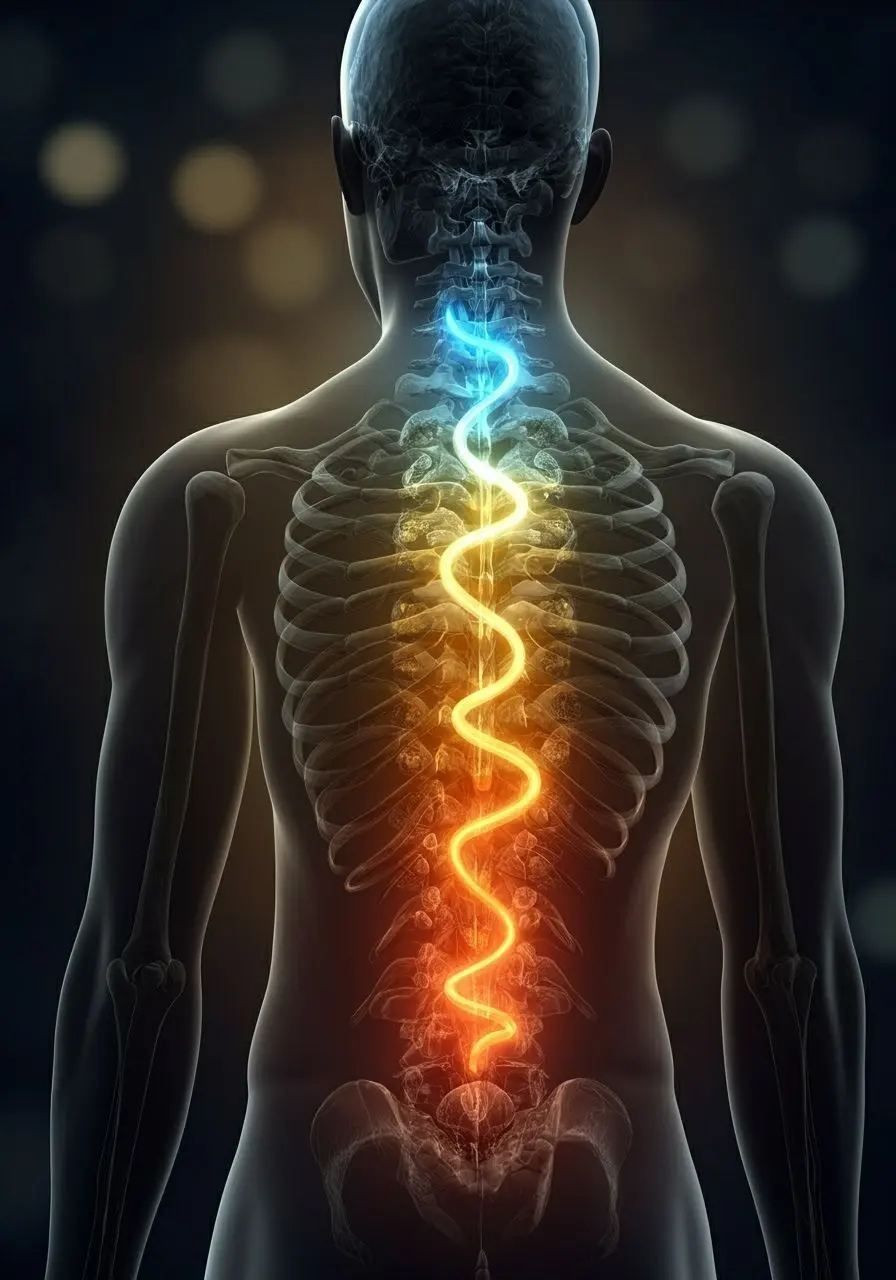
Most people lean heavily into one channel. Too much pingala and you're wired, anxious, burning out. Too much ida and you're sluggish, unmotivated, foggy. Balance means both channels flow evenly while sushumna stays clear.
Breathing and chakras work together to create this balance. Alternate nostril breathing - switching between left and right - harmonizes ida and pingala. Deep belly breathing through both nostrils activates sushumna. Combined practice clears all three channels.
You'll feel the difference within minutes.
Ancient yogis didn't have fMRI machines, but they understood something profound about breath and consciousness. Modern research now validates what they taught thousands of years ago.
Controlled breathing directly impacts your autonomic nervous system. Slow, deep breaths activate your vagus nerve - the main component of your parasympathetic system. This triggers your relaxation response. Heart rate drops. Blood pressure decreases. Stress hormones decline.
Fast, shallow breathing does the opposite. It signals danger to your nervous system, triggering fight or flight. Most people breathe this way all day without realizing it.
Breathing exercises for root chakra work because they force your breath lower, activating your diaphragm fully. This mechanical action alone shifts your nervous system state. Add intention and energy awareness? The effects multiply.
Your breath also affects cerebrospinal fluid flow around your brain and spine. Research shows that breathing patterns influence this flow, which impacts brain function and potentially the energy channels running along your spine.
Here's something interesting. Brain imaging studies show that focusing attention on specific body parts increases neural activity in corresponding brain regions. When you direct awareness to your heart center during breathing exercise for heart chakra, you're actually creating new neural pathways.
Do this repeatedly and those pathways strengthen. Your brain becomes better at sensing that area. What feels like energy movement might be increased proprioception, blood flow, and neural activation. Or it might be something we can't measure yet.
Doesn't really matter which. The practice works.
People notice changes fast with consistent practice. Some benefits show up immediately. Others develop over weeks or months. What you experience depends on which chakras need work and how blocked your energy system is.
Physical benefits include better sleep, reduced pain, improved digestion, more energy. Your immune system functions better when your nervous system isn't stuck in stress mode. Chakra breathing benefits extend to every system in your body because breath affects everything.
Emotional regulation improves. That knot of anxiety in your chest loosens. Stuck emotions start moving through instead of staying trapped. You feel things more clearly but less overwhelmingly.
Mental clarity increases. Brain fog lifts. Focus sharpens. The constant mental chatter quiets down when you're not breathing shallow and feeding your stress response.
Your intuition gets stronger. Third eye activation isn't mystical nonsense - it's about accessing parts of your brain that get drowned out by stress and overthinking. Clear the channels and information flows better.
Connection deepens. To yourself, to others, to something larger. Crown chakra work opens you up without making you spacey or disconnected from reality.
Better posture happens naturally. When you breathe properly, your body realigns itself. Shoulders drop. Spine lengthens. That forward head position that causes neck pain? Starts correcting itself.
Start here before moving to individual chakra work. These foundational techniques teach you to direct breath and attention through your entire energy system.
This technique wakes up your entire torso and all seven chakras. Most people only breathe into their upper chest.
Three-part breath teaches you to use your full capacity.
Sit comfortably. Spine straight but not rigid. Place one hand on your belly, one on your chest.
Inhale slowly through your nose.
That's three parts: belly, ribs, chest.
Exhale in reverse. Empty your upper chest first. Then your ribcage. Finally, draw your belly in to push out the last bit of air.
Go slow. Really slow. Each inhale should take 4-6 seconds. Each exhale the same or longer.
Five rounds of this and you'll feel different. Your whole system shifts.

This chakra breathing meditation moves energy through all seven centers in one practice. Takes about 15 minutes once you know it.
Sit or lie down. Close your eyes. Take three deep breaths to settle in.
Reverse the sequence. Move back down from crown to root, spending four breaths at each center. This grounds the energy you just activated.
Finish with your attention back at your root. Three deep breaths.
Open your eyes slowly.
Experience deep inner balance with this 10-minute Chakra Breathing Meditation.
Whether you're seeking clarity, peace, or energetic alignment, this guided journey through all seven chakras will help restore harmony to your mind, body, and spirit.
Perfect for any experience level - just press play and breathe.
Video by Zen Vibes | Watch on YouTube
Each chakra responds to specific breathing techniques. These practices target individual centers when you need focused work on one area. The table below provides a comprehensive overview of breathing methods for all seven chakras, from foundational techniques to advanced practices with mantras.
Structured meditation practices give you frameworks for consistent work. These are the methods people return to repeatedly.
This extended practice takes 30-45 minutes. You're spending real time with each energy center, allowing deeper clearing and activation.
Set up in a quiet space where you won't be interrupted. Sit comfortably with your spine aligned. Have water nearby - you'll want it after.
Begin with five minutes of natural breathing. Just observe your breath without changing it. This settles your system.
Start at your root chakra. Spend five full minutes breathing through chakras, beginning here. Don't rush. Place your hands on your lower belly if that helps you focus. Visualize roots growing down from the base of your spine into the earth.
Move to each subsequent chakra, spending five minutes at each center. As you progress upward, you might notice energy building, tingling, heat, or emotion. All normal.
After you've spent five minutes at your crown, take five minutes to feel the entire column of energy from root to crown as one unified system. Breathing through chakras sequentially creates this integrated awareness.
Finish with grounding. Bring your attention back to your root chakra and take several deep breaths there. This prevents spaciness or feeling ungrounded after working with your upper chakras.
The Osho chakra breathing meditation is intense. Active. Loud. Completely different from quiet seated practice. Osho designed this technique to break through stuck energy using sound, movement, and rapid breathing.
This practice lasts one hour. You need space and tolerance for noise - your own. Osho chakra breathing meditation instructions divide the hour into stages.
The Osho meditation chakra breathing method isn't for everyone. But when you're deeply stuck and gentle techniques aren't cutting through, this practice breaks things open. You can find Osho chakra breathing meditation music free download online - specific music guides each stage.
Fair warning: you'll feel exhausted and raw afterward. Plan accordingly.
Once you've established a basic practice, these advanced techniques take you deeper.
Breath retention supercharges energy activation. The basic pattern: inhale to a specific chakra, hold your breath while focusing there, exhale from that chakra.
Start with your root. Inhale deeply for four counts, visualizing energy entering your root chakra. Hold for four counts while all your attention stays at the base of your spine. Exhale for four counts, releasing any blocked energy.
Work through all seven chakras this way. As you get comfortable, extend the holds. Six counts, then eight. Some advanced practitioners hold for 30 seconds or more.
Never force retention. If you feel dizzy or anxious, shorten the holds. This technique is powerful precisely because it's not gentle.
This method works with your ida and pingala channels while targeting specific chakras. You're balancing lunar and solar energy at each center.
Use alternate nostril breathing combined with chakra focus. Close your right nostril. Inhale through your left nostril while focusing on your root chakra. Hold briefly. Close your left nostril, open your right, exhale through your right nostril.
Now inhale through your right nostril, still focusing on your root. Hold. Switch and exhale through your left.
That's one complete round for one chakra. Do three rounds per chakra, moving up from root to crown.
This practice creates remarkable balance. People notice effects immediately.
Each chakra resonates with a specific sound frequency. Combining these seed sounds - bija mantras - with breath amplifies the effects.
Inhale deeply to a chakra. As you exhale, chant that chakra's sound. The vibration you create actually resonates in that area of your body. Not metaphorically - you feel it.
Do 5-10 rounds per chakra. The sound creates a feedback loop, intensifying your awareness of that energy center.
Research into breathwork has exploded over the past decade. Scientists are finally studying what yogis have known for millennia.
Studies show that slow breathing - around six breaths per minute - optimizes autonomic nervous system function. This rate maximizes heart rate variability, a marker of nervous system health and resilience.
One study found that just five minutes of slow breathing significantly reduced anxiety and increased feelings of calmness. The effect lasted for hours after the practice ended.
Another line of research examines vagal tone - how well your vagus nerve functions. Higher vagal tone correlates with better emotional regulation, reduced inflammation, and improved mental health. Guess what increases vagal tone? Slow, deep breathing.
Researchers studying specific breathing techniques found measurable changes in immune function. One study on Wim Hof breathing - a method that shares similarities with intensive chakra breathing - showed practitioners could voluntarily influence their immune response.
After training, participants showed increased epinephrine production and reduced inflammatory markers when exposed to endotoxins. Their breathing practice literally changed how their immune system responded to threats.
Heart rate variability (HRV) measures the variation in time between heartbeats. Higher HRV indicates better health, emotional regulation, and stress resilience. Breathing practices directly influence HRV.
Heart-focused breathing - essentially heart chakra breathing - creates something called cardiac coherence. Your heart rhythm becomes more ordered and harmonious. This state correlates with reduced stress, better cognitive performance, and improved emotional stability.
HeartMath Institute research demonstrates that just three minutes of heart-focused breathing can shift you into coherence. The effects build with regular practice.
Clinical trials show breathing exercises help treat anxiety, depression, and PTSD. One meta-analysis found that breathing-based interventions significantly reduced symptoms across multiple mental health conditions.
The mechanism isn't mysterious. Chronic stress keeps your sympathetic nervous system activated. This dysregulates neurotransmitter production, hormone levels, and brain function. Breathing practices reset your nervous system, allowing normal regulation to resume.
Trauma-focused therapy increasingly incorporates breathing work. Trauma lives in your body, not just your mind. Chakra breathing exercises help release stored trauma by working directly with the nervous system.
Breathing practices reduce both acute and chronic pain. Research shows slow breathing activates pain-inhibiting systems in your brain and spinal cord.
One study on chronic pain patients found that eight weeks of breathing practice reduced pain intensity and improved quality of life. Participants also used less pain medication.
The connection to chakra work becomes clear when you consider where people hold pain. Lower back pain often correlates with root chakra issues. Digestive problems with solar plexus blockages. Breathing exercises that target these specific areas address both the physical symptoms and the underlying energy disruption.
Theory means nothing without consistent practice. Here's how to actually make this work in your real life.
Start small. Seriously.
Five minutes daily beats an hour once a week. Your nervous system needs regular input to create lasting change.
Morning works best for most people.
Before your mind fills with the day's demands, before your feet hit the floor. Sit up in bed and do basic chakra breathing for five minutes.
If mornings don't work, find your window. Random Tuesday afternoon during lunch break. Evening before dinner.
Consistency matters more than timing.
Create a simple routine and stick to it for 30 days.
That's how long it takes for a practice to become automatic.
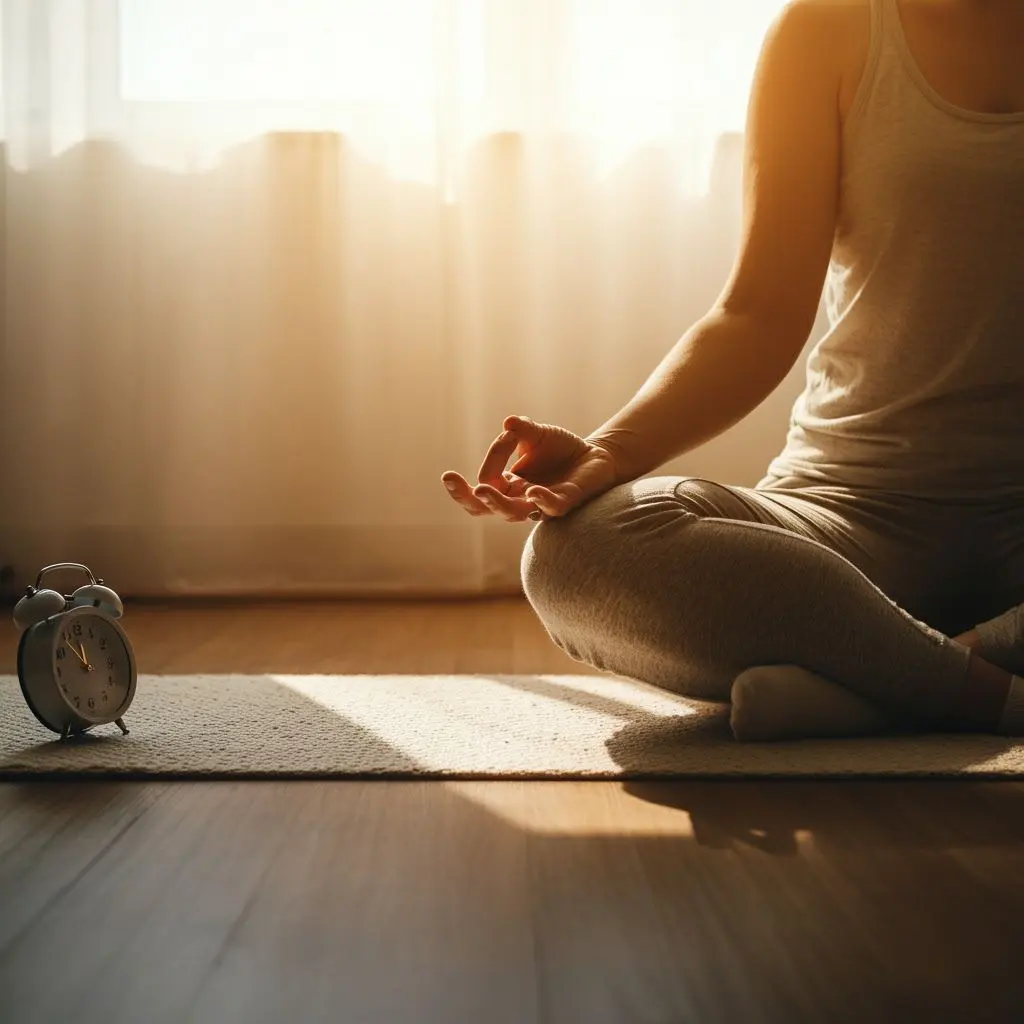
A balanced weekly schedule includes variety. Different techniques serve different purposes.
Adjust based on what you notice. If you're feeling ungrounded, add more root chakra work. Anxious? Extended heart chakra breathing. Foggy? Third eye focus.
Keep a simple practice log. Date, technique used, duration, and what you noticed. That's it.
After two weeks, patterns emerge. You'll see which practices affect you most strongly. Which chakras consistently feel blocked. How your energy shifts over time.
Some people notice physical changes first - better sleep, more energy, reduced pain. Others notice emotional shifts - less anxiety, more resilience. Both are valid markers of progress.
Don't track too much. This isn't about perfection or achievement.
You're developing sensitivity to your own energy system. That awareness itself is the goal.
We've created a printable practice log to make tracking easier.
It includes space for ten sessions with fields for date, technique, duration, chakras worked, and observations.
Click the image to open, print, or download the log for your personal use.
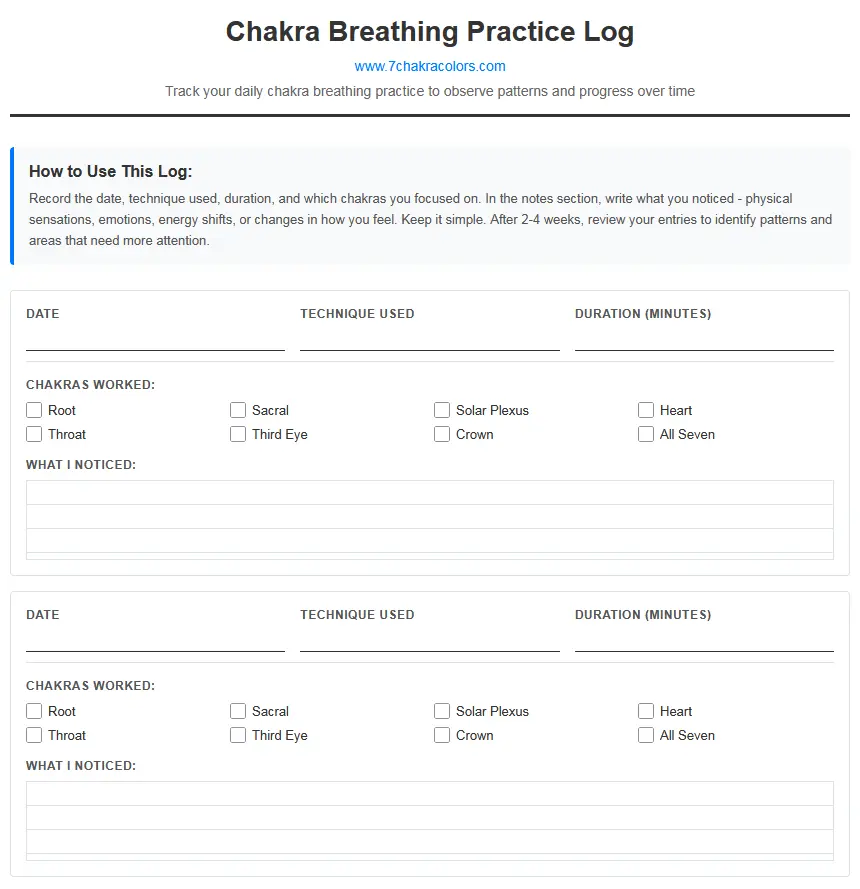
Everyone hits obstacles. Here's how to work through the most common ones.
Normal. Especially at first. Your sensitivity develops over time. Meanwhile, trust that the practice works even when you don't feel dramatic sensations.
Try this: place your hands on the chakra you're working with. Physical touch increases awareness. Focus on actual sensations - warmth, tingling, pressure, tension - rather than waiting for mystical experiences.
Sensation isn't the point anyway. The physiological changes happen whether you feel them or not.
You're moving energy too fast or working with upper chakras when your foundation isn't stable. Back up. Spend a week doing only root chakra work. Ground before you try to fly.
Shorten your practice sessions. Three minutes of grounded breathing beats 30 minutes that leaves you anxious.
Always finish practice with grounding. Bring your attention to your feet, your root, your connection to earth. This prevents the spacey, ungrounded feeling that comes from excessive upper chakra work.
You're either deeply exhausted or lying down when you should sit up. If exhaustion is the issue, let yourself sleep. Your body needs rest more than it needs practice right now.
If position is the problem, sit in a chair or cross-legged on the floor. Spine straight. This keeps you alert while still being comfortable.
Then don't do long practices. Five quality minutes beats zero minutes. One conscious breath beats mindless breathing all day.
Integrate chakra breathing techniques into existing routines. Three breaths to your root chakra while your coffee brews. Heart chakra breathing while you're stopped at a red light. Crown chakra attention for 30 seconds before you open your work computer.
These micro-practices add up. Your nervous system doesn't know the difference between formal meditation and integrated awareness.
Of course it won't. That's what minds do.
Don't fight the thoughts. Let them run in the background while you keep your attention on breath and body sensation. Racing thoughts aren't a problem unless you decide they are. You're training focus here, not trying to achieve some perfectly blank mental state.
When your attention drifts - and it will, constantly at first - just bring it back to the chakra you're working with. No judgment. No frustration. That redirection is the practice.
Actually, the more scattered your mind feels, the more you probably need this work. Stick with it.
Good. That means something's moving.
Chakras hold stuck emotions. When you breathe into them with intention, those feelings release. Crying, anger, sudden sadness - all normal. Your body is doing exactly what it needs to do.
Don't stop the practice when emotions come up. That's the moment to keep breathing, keep focusing, let whatever needs to release actually release. Have tissues nearby. Give yourself time afterward to process.
If it gets too intense, shift focus to your root chakra for a few breaths. Ground yourself. Then decide whether to continue or stop for the day.
Sharp pain? Stop immediately. That's your body saying something's wrong.
Mild discomfort, pressure, or temporary aching? Usually fine. You're moving energy through areas that have been blocked. Some sensation comes with that. Like foam rolling a tight muscle - it's not exactly comfortable, but it's working.
Listen to your body. There's a difference between "this feels weird but tolerable" and "this actually hurts." Learn to recognize where that line is for you.
Position matters too. If your back hurts, adjust how you're sitting. If your jaw tenses up, consciously relax it. Physical comfort supports energetic work.
How long have you been practicing? Week? Two weeks?
Some people feel shifts immediately. Others need months of consistent practice before noticing changes. Your energy system has been stuck in certain patterns for years - maybe decades. It doesn't reorganize overnight.
Track subtle changes. Sleeping better? Less reactive to stress? Breathing deeper without thinking about it? Those count. Don't wait for lightning bolts and mystical visions.
Also check your expectations. This practice creates real changes, but they're often quiet. Gradual. The kind of thing you notice when you look back over weeks and realize something fundamental has shifted.
So practice with the noise.
Waiting for perfect silence means you'll rarely practice. Dogs bark. Cars pass. Someone's always mowing a lawn somewhere. Your chakras don't care. The breath works regardless.
Use sound as part of the practice instead of fighting it. External noise, internal noise - both just background. Your focus on breath and chakra is foreground. That's all that matters.
If you truly can't focus, fine - close a window, find a quieter spot. But don't let imperfect conditions become an excuse to skip practice entirely.
You just learned a complete system for working with your energy through breath. Simple techniques that create real changes in your body, emotions, and consciousness.
Start where you are. Pick one technique from this guide and practice it daily for a week. Notice what shifts. Then add another practice. Build gradually.
Your breath is always with you. Every inhale is an opportunity to direct energy where you need it. Every exhale releases what's stuck. This isn't complicated mysticism requiring years of training.
It's practical technique you can use right now.
Sitting in your car before work. Standing in your kitchen. Lying in bed before sleep. Anywhere, anytime. That's the beauty of chakra breathing - it works wherever you are.
Your energy system wants to flow freely. Blockages aren't permanent. Stuck patterns can shift. Balance is possible. You just learned exactly how to make that happen.
So breathe. Direct your attention. Notice what changes. That's the entire practice.
Disclaimer: The information in this article is for educational purposes only and should not replace professional medical advice. Consult with a healthcare provider before beginning any new breathing practice, especially if you have respiratory, cardiovascular, or mental health conditions.
Chakra breathing is a meditation technique that uses intentional breathwork to direct prana (life force energy) through your seven energy centers. By focusing your breath and attention on specific chakras, you activate, clear, and balance the energy flow in these centers. The practice works because breath carries prana throughout your body - where your attention goes during breathing, energy follows. This creates measurable physiological changes including improved nervous system function, better circulation, and enhanced neural activity in the areas you focus on.
Start with 5 minutes daily for beginners. Individual chakra work typically takes 5-10 minutes per center. A full seven-chakra meditation practice runs 30-45 minutes. Consistency matters more than duration - daily 5-minute sessions create better results than occasional hour-long practices. Build your practice gradually and listen to your body's signals about what feels sustainable.
Yes. Chakra breathing directly activates your parasympathetic nervous system (rest and digest mode), reducing stress hormones and anxiety. Slow, deep breathing activates the vagus nerve, which triggers your relaxation response. Root chakra breathing specifically grounds scattered energy and reduces anxiety. Heart chakra breathing calms emotional overwhelm. Research shows even 5 minutes of controlled breathing significantly reduces anxiety and increases feelings of calm, with effects lasting hours after practice.
The heart chakra (Anahata) and throat chakra (Vishuddha) directly relate to breathing and respiratory function. The heart chakra governs the lungs and breath rhythm, while the throat chakra controls the airways and breath flow. However, all chakras benefit from breathwork because breath carries prana through your entire energy system. The diaphragm - your primary breathing muscle - connects to the solar plexus chakra, making proper breathing essential for this power center's activation.
No experience required. Basic chakra breathing is simple - breathe into your lower belly while focusing on the base of your spine. That's the fundamental technique. Start there and build gradually. Your ability to feel or visualize energy develops over time with practice. The physiological benefits happen whether you're experienced or not. If you can breathe and direct your attention, you can practice chakra breathing effectively.
Pranayama is the broad category of yogic breathing techniques. Chakra breathing specifically combines pranayama methods with focused attention on the seven energy centers. Traditional pranayama like alternate nostril breathing (nadi shodhana) or breath of fire (kapalabhati) can be practiced alone or directed toward specific chakras. Chakra breathing adds the element of energy awareness and chakra-specific visualization to pranayama techniques, making the practice more targeted for balancing your energy system.
When practiced correctly, chakra breathing is safe. Potential side effects are minor - lightheadedness from breathing too rapidly, emotional release (crying), or feeling spacey from excessive upper chakra work. Avoid if you're pregnant, have uncontrolled high blood pressure, or recent abdominal surgery without consulting a doctor first. If you feel dizzy, slow down your breathing. If anxiety increases, focus on root chakra work for grounding. Always finish practice with grounding techniques to prevent feeling disconnected.
Morning works best for most people - before your mind fills with daily demands. Practice right after waking, even before getting out of bed. Your mind is naturally quieter and more receptive. Evening practice before sleep can be effective for relaxation-focused work, though intense techniques like breath of fire might energize you too much. Ultimately, the best time is whenever you'll actually practice consistently. Lunchtime, afternoon breaks, or any regular slot that fits your schedule works fine.
Start with symptoms and feelings. Anxiety, feeling ungrounded, or financial stress points to root chakra. Creative blocks or emotional numbness indicates sacral chakra. Low confidence suggests solar plexus needs work. Relationship issues or closed-off feelings mean heart chakra. Difficulty expressing yourself signals throat chakra. Mental fog or disconnection from intuition points to third eye. Lack of purpose or spiritual emptiness indicates crown chakra. When unsure, work through all seven in sequence from root to crown, spending 4-5 breaths at each center.
Sitting is generally better because it keeps you alert and maintains proper spinal alignment for energy flow. Lying down works for gentle practices or if you have back issues, but you're more likely to fall asleep. If you lie down, keep your spine straight. Intensive practices like breath of fire or Osho chakra breathing require standing or sitting positions. For basic breathing and visualization, any comfortable position with a straight spine works - chair, floor, cushion, or even your parked car seat.
Bija mantras are seed sounds that resonate with specific chakra frequencies: LAM (root), VAM (sacral), RAM (solar plexus), YAM (heart), HAM (throat), OM (third eye), and AUM (crown). You don't need to use them, but they amplify the effects of chakra breathing. The vibration you create while chanting these sounds literally resonates in the corresponding body area. Start with silent breathing to learn the basics, then add mantras later if you want to deepen your practice. Chant on your exhale for 5-10 rounds per chakra.
Some effects happen immediately - calmer nervous system, deeper breathing, reduced tension. Others develop over weeks. Many people notice better sleep, improved mood, or reduced anxiety within 1-2 weeks of daily practice. Significant energy shifts and chakra opening typically take 4-8 weeks of consistent practice. Long-standing blockages may need several months. Track subtle changes rather than waiting for dramatic experiences. Sleeping better, breathing deeper without thinking about it, and feeling less reactive to stress all count as results.

